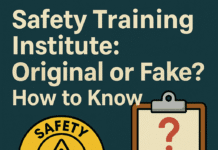
Occupational Hygiene and Safety Technician (OHST)
Occupational Hygiene and Safety Technicians (OHSTs) play a pivotal role in ensuring workplace safety and minimizing occupational hazards. These professionals are tasked with monitoring, assessing, and implementing safety protocols to safeguard employees’ health and well-being.
Introduction to Occupational Hygiene and Safety Technician (OHST)
In today’s dynamic work environments, the presence of OHSTs is indispensable. Their responsibilities encompass a wide array of crucial tasks aimed at creating a safe and healthy workplace culture. Whether it’s conducting risk assessments, implementing safety measures, or monitoring conditions, OHSTs are instrumental in mitigating potential risks.
Qualifications and Education Requirements
Becoming an OHST typically requires a blend of educational background and specialized training. While specific qualifications may vary, a foundation in fields such as occupational health, safety engineering, or related disciplines is often essential. Certifications and ongoing training further augment their expertise, ensuring they stay updated with industry standards and best practices.
Duties and Responsibilities of an OHST
OHSTs are entrusted with the responsibility of continuously evaluating workplace conditions. They perform detailed risk assessments, utilizing various tools and techniques to identify potential hazards. Implementing safety protocols and ensuring compliance with regulatory standards are paramount aspects of their role.
Tools and Techniques Used by OHSTs
Equipped with an array of sophisticated tools and techniques, OHSTs conduct sampling, measure safety parameters, and utilize technology-driven applications to assess and address workplace safety concerns. These tools aid in accurate data collection and analysis, facilitating informed decision-making.
OHSTs in Various Industries
The versatility of OHSTs is reflected in their presence across diverse industries. Whether it’s the high-risk environment of construction sites, the precision-demanding healthcare sector, or the manufacturing industry, OHSTs adapt their expertise to meet industry-specific safety needs.
Importance of OHSTs in Workplace Safety
The pivotal role of OHSTs extends beyond mere compliance; they actively contribute to preventing accidents, injuries, and occupational illnesses. Their proactive measures create a safer work environment, fostering productivity and employee well-being.
Career Growth and Opportunities
For those aspiring to pursue a career as an OHST, there are ample opportunities for growth. Continuous learning, certifications, and skill development pave the way for advancement within the field, offering a rewarding and fulfilling career path.
Challenges Faced by OHSTs
However, the role of an OHST isn’t devoid of challenges. Balancing stringent compliance requirements with maintaining productivity levels poses a constant challenge. Moreover, the evolving nature of safety concerns demands adaptive strategies.
An Occupational Hygiene and Safety Technician (OHST) is a professional responsible for ensuring workplaces adhere to health and safety regulations. They specialize in identifying, assessing, and mitigating workplace hazards to protect employees from potential risks. OHSTs conduct inspections, evaluate safety procedures, and recommend improvements to minimize occupational health threats. They might also provide training to employees on safety protocols and assist in creating emergency response plans. Their goal is to create and maintain a safe and healthy work environment for all employees.Future Trends in Occupational Hygiene and Safety
The landscape of occupational hygiene and safety is evolving rapidly. Technological advancements, coupled with changing regulatory frameworks, are reshaping the way OHSTs approach their responsibilities. Embracing innovation is key to staying ahead in this dynamic field.
Case Studies Highlighting OHST Impact
Numerous instances underscore the significant impact OHSTs have made in enhancing workplace safety. These case studies serve as testimonials to their crucial role in preventing incidents and safeguarding employees.
Best Practices for Aspiring OHSTs
Aspiring OHSTs should focus on acquiring diverse skill sets, staying updated with industry trends, and actively engaging in continuous education and training. Networking and mentorship can also greatly benefit those entering the field.
Community Involvement and Advocacy
Beyond their workplace duties, OHSTs often engage in community initiatives and advocacy programs aimed at promoting safety awareness. Their involvement extends beyond office walls, contributing to broader societal well-being.
Cost-Benefit Analysis of Employing OHSTs
Investing in OHSTs yields significant benefits, not just in terms of mitigating risks but also in cost savings due to reduced incidents, improved employee morale, and enhanced productivity.
Global Perspectives on Occupational Hygiene and Safety
The role and practices of OHSTs vary across the globe due to cultural, regulatory, and industrial differences. Understanding these global perspectives offers valuable insights into diverse approaches to occupational safety.
Conclusion
In conclusion, Occupational Hygiene and Safety Technicians are indispensable assets in ensuring workplace safety and mitigating occupational hazards. Their multifaceted roles, coupled with their dedication to safeguarding employees, make them instrumental in fostering a culture of safety.
Safety Management Specialist (SMS)
How to Obtain SAMTRAC Certification
FAQs
- What qualifications are needed to become an OHST? To become an Occupational Hygiene and Safety Technician (OHST), a blend of education and training is essential. Typically, a background in occupational health, safety engineering, or related fields is required. Additionally, certifications and ongoing training further enhance expertise in this field.
- How do OHSTs contribute to workplace safety? OHSTs play a pivotal role in workplace safety by monitoring conditions, conducting risk assessments, and implementing safety protocols. They identify potential hazards, mitigate risks, and ensure compliance with safety standards, fostering a safe work environment.
- What challenges do OHSTs face in their roles? OHSTs encounter challenges in balancing strict compliance requirements while maintaining productivity levels. Additionally, the evolving nature of safety concerns demands adaptive strategies to address emerging risks effectively.
- Are there growth opportunities for OHSTs? Yes, there are ample growth opportunities for OHSTs. Continuous learning, certifications, and skill development pave the way for advancement within the field. OHSTs can pursue various career paths and contribute significantly to workplace safety.
- What are the future trends shaping the field of occupational hygiene and safety? The future of occupational hygiene and safety is evolving with technological advancements and changing regulatory frameworks. Embracing innovation, incorporating new technologies, and adapting to evolving standards are key trends shaping the field.
























